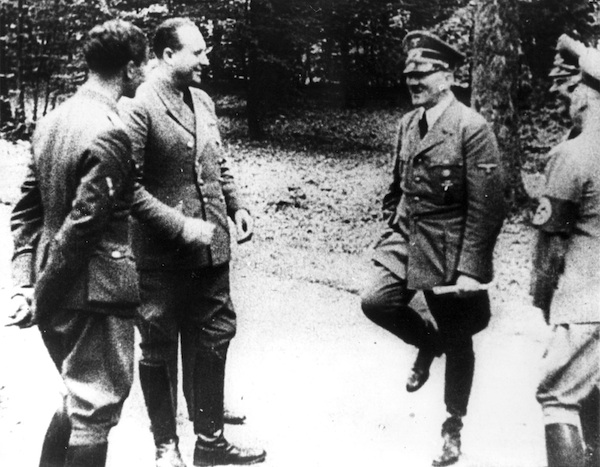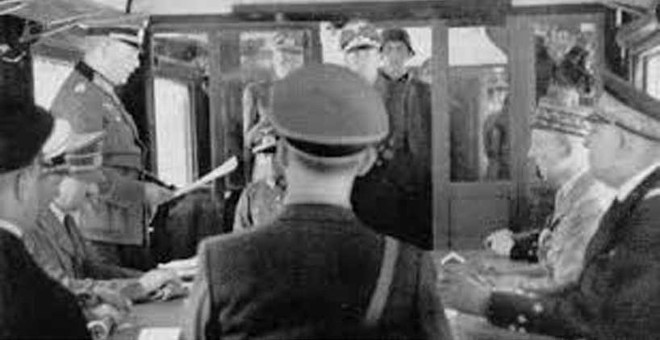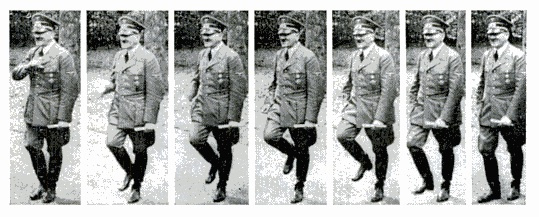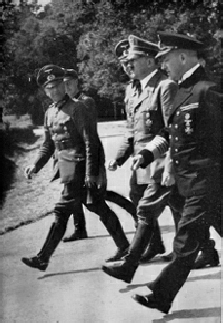Friday 21 June 1940
 |
| The victors meet the vanquished at Compiegne. |
Western Front: Adolf Hitler on 21 June 1940 travels to Compiegne to be at the armistice negotiations, which commence at 15:30. The agreement, which is a foregone conclusion but whose exact terms are still to be negotiated, is to be signed in Marshal Foch's old railway carriage at the Glade of the Armistice. Hitler, in a moment of inspiration, has decided that this museum piece would be the appropriate location for French capitulation because it is where the Germans surrendered in 1918.
It is difficult to overemphasize the importance of this day on the German psyche of the times. As one Wehrmacht officer notes, "The battle of France is over; it lasted 22 years."
Hitler is in an excellent mood. It likely is the happiest day of his life. A German diplomat, Erich Tuch, spots him in nearby woods practicing his "moves," laughing and strutting about, before the ceremony. He spends only about 15 minutes at what he considers to be a largely ceremonial occasion. British newsreels have endless fun looping some video of him which creates the appearance that he dances the jig at one point when in fact he simply lifts one leg high in exuberance as if to imitate dancing in joy.
 |
| Hitler high-stepping at Compiegne due to the French surrender. |
Hitler then becomes unreachable, which causes problems. He has ordained that there be a vestigial French state in the south, that the French armed forces be demobilized, and that the French pay huge indemnities at an artificially inflated exchange rate. The French delegation led by General Huntzinger begins quibbling over details despite Hitler's peremptory attitude. Without Hitler present, General Keitel (who gets in some useful practice at surrenders which will come in handy later) does not feel authorized to make any decision. Thus, the "negotiations" drag on throughout the day in the stifling railway car. During the night, General Weygand, Admiral Darlan, and Prime Minister Petain's cabinet begin coming up with their own clever ideas about the terms, but caution Huntzinger to get the German signatures on the document one way or the other.
Evacuations pursuant to Operation Ariel continue at St Jean-de-Luz.
Mussolini is desperate to provide his military bona fides, so he launches a land offensive against French positions in the Alps. The troops take off at 05:30 while an unusual June snowstorm is in progress. Crown Prince Umberto has the honor of leading the 32 Italian Divisions divided into two armies (Italian 1st Army and 4th Army) in the pointless operation. The French, under the command of René Olry, defend with three divisions.
The French hold their positions at the Little Saint Bernard Pass in the Alps easily because the mountain passes are extremely easy to defend. The Italians have better luck along the narrow coastal plain on the Riviera/Côte d'Azur. There, they advance about five miles before being stopped by a scratch force composed of a French NCO with 7 men. Mussolini reportedly is embarrassed by the small gains, which he has been trying to wedge in before the signing of the Armistice at Compiegne.
 |
| Hitler (hand on hip) admires the statue of General Foch before boarding Foch's railway carriage for the Armistice proceeding. |
The RAF attacks German shipping and an oil depot at Willemsoord, Holland. RAF Bomber Command puts 10 aircraft over Germany during the day and 105 overnight.
Battle of the Atlantic: U-28 (Kapitänleutnant Günter Kuhnke) torpedoes and sinks 4,443 ton Royal Navy special service ship HMS Prunella (X 02) on the Southwest Approaches. There are 40 survivors, and 56 crew perish.
U-38 (Kapitänleutnant Heinrich Liebe) torpedoes and sinks 5,809-ton Belgian freighter Luxembourg west of St. Nazaire, France. There are 41 survivors and 5 perish.
U-43 (Kapitänleutnant Wilhelm Ambrosius) torpedoes and sinks 8,627-ton British tanker Yarraville southwest of Figueira da Foz, Portugal in the eastern Atlantic Ocean. There are 45 survivors and 5 perish.
U-47 (Kapitänleutnant Günther Prien) torpedoes and sinks 13,056-ton British tanker San Fernando 50 miles southwest of Cape Clear, Ireland. All 49 onboard survive.
U-52 (Kapitänleutnant Otto Salman) torpedoes and sinks 1,144-ton French freighter Hilda in the Bay of Biscay. There are 11 survivors and 5 perish.
U-65 (Kapitänleutnant Hans-Gerrit von Stockhausen) torpedoes and sinks 1,177-ton Dutch freighter Berenice in the Bay of Biscay. The ship sinks in 3 minutes, and there are 9 survivors and 38 perish.
U-122 (Korvettenkapitän Hans-Günther Looff), which sank SS Empire Conveyor only one day ago, goes missing. There are several theories about its disappearance, and one of the more promising is that Polish submarine ORP Wilk rammed the U-boat while it was attempting to dive.
HMS H44, a submarine, sinks Danish freighter Alfa in the North Sea.
Kriegsmarine S-boots (fast torpedo boats) S-21 and S-32 hit mines and sink off Boulogne.
British Special Service (decoy) Vessel Prunella is sunk by U-28 off Ireland. There are 40 survivors and 54 crew perish.
U-99 (Otto Kretschmer) is unexpectedly returning to Bergen with a sick crewman when an Arado 196 scout plane from the Scharnhorst spots it. The seaplane attacks the U-boat and damages it, then two other Luftwaffe aircraft also attack, causing minor damage that requires repairs at Wilhelmshaven.
Kriegsmarine heavy cruiser Scharnhorst is limping home from Trondheim. The RAF Coastal Command sends six Swordfish torpedo bombers against it at 15:00, but they make no hits as the Scharnhorst mounts an effective anti-aircraft defense. Gneisenau, also torpedoed, makes it safely back to Trondheim.
Convoy OA 172 departs from Southend, Convoy HG 35 departs from Gibraltar, Convoy OG 34 forms at Gibraltar, Convoy HX 52 departs from Halifax.
British destroyer HMS Hurricane (H 06, Lt. Commander Hugh C. Simms) is commissioned.
 |
| Hitler, left, listens as General Keitel (standing) reads the preamble to the Armistice agreement. Hitler left immediately afterward. Around the table are Hermann Goering, Admiral Raeder, Foreign Minister Ribbentrop, General Huntzinger. |
The Regia Aeronautica raids Malta and Bizerte and attacks French warships near the Balearic Islands.
French battleship Lorraine bombards Italian positions at Bardia.
Romania: King Carol, who has just pardoned Iron Guard members, forms the National Party for them. Jews are excluded from membership.
Canada: Alexander Cambridge, 1st Earl of Athlone, becomes the 16th Governor-General of Canada. The parliament passes the National Resources Mobilization Act. Another contingent of Canadian soldiers arrives in Great Britain.
Estonia: The new Soviet puppet government is acclaimed in numerous demonstrations across the country by Soviet troops and sympathizers.
Poland: The Polish President arrives in England after being evacuated from southern France.
Brazil: US heavy cruiser USS Wichita (CA 45, Commander Cruiser Division Seven Rear Admiral Andrew C. Pickens) arrives at Rio de Janeiro as part of the US Navy's "show the flag" operation for South America. Its next port of call will be Montevideo, Uruguay to join the USS Quincy (CA 39), which arrived there on the 20th.
Japanese Government: Prince Konoye forms a new Cabinet. General Tojo becomes Minister of War.
French Government: The French are still divided over the possibility of further resistance from North Africa. French warship Massilia takes Minister Georges Mandel, a few members of the French government, and a few members of Parliament to North Africa.
Applied Science: R.V Jones, head of British Scientific Intelligence, testifies to a secret committee that the Luftwaffe is using the "Knickebein" (crooked leg) radio beam navigational system to find their targets. This system has proven fairly effective despite being primitive. The British quickly put in motion a method to detect the beams using specially equipped RAF Anson aircraft and work on other counter-measures.
Henry Tizard, who is largely responsible for the British use of the radar detection system, resigns out of frustration at being side-tracked on his advice. His resignation means that Frederick Lindemann (Lord Cherwell), generally considered to be less clever than Tizard, becomes Churchill's principal scientific advisor.
French Homefront: Refugees terrified of the advancing Germans are stopped at the Spanish border by Franco's men and not allowed in.
British Homefront: Everyone is on edge throughout the country regarding infiltrators and paratroopers. The Times publishes a chart for distinguishing a German paratrooper from a regular British policeman.
American Homefront: General John T. Thompson dies in Great Neck, New York. Thompson was an officer during World War I who worked up the Thompson Machine Gun. The "Tommy Gun" became so ubiquitous during World War II that Wehrmacht troops took to calling Allied soldiers "Tommies."
Future History: Mariette Hartley is born in Weston, Connecticut. She becomes famous as a television actress in the 1960s and 1970s.
 |
| German Dornier Do 17Z light bombers fly over France on June 21, 1940. |
June 1, 1940: Devastation at Dunkirk
June 2, 1940: Hitler Visits France
June 3, 1940: Operation Paula
June 4, 1940: We Shall Fight
June 5, 1940: Fall Rot
June 6, 1940: Weygand Line Crumbling
June 7, 1940: British Evacuating Narvik
June 8, 1940: Operation Juno
June 9, 1940: Norway Capitulates
June 10, 1940: Mussolini Throws Down
June 11, 1940: Paris an Open City
June 12, 1940: Rommel at St. Valery
June 13, 1940: France Goes Alone
June 14, 1940: Paris Falls
June 15, 1940: Soviets Scoop Up Lithuania
June 16, 1940: Enter Pétain
June 17, 1940: The Lancastria Sinks
June 18, 1940: A Day of Leaders
June 19, 1940: U-boats Run Wild
June 20, 1940: Pétain Wilts
June 21, 1940: Hitler's Happiest Day
June 22, 1940: France Is Done
June 23, 1940: Hitler in Paris
June 24, 1940: Six Million Jews
June 25, 1940: German Celebrations
June 26, 1940: USSR Being Belligerent
June 27, 1940: Malta in Peril
June 28, 1940: Channel Islands Bombed
June 29, 1940: Gandhi Insists on Independence
June 30, 1940: Channel Islands Occupied
2020





